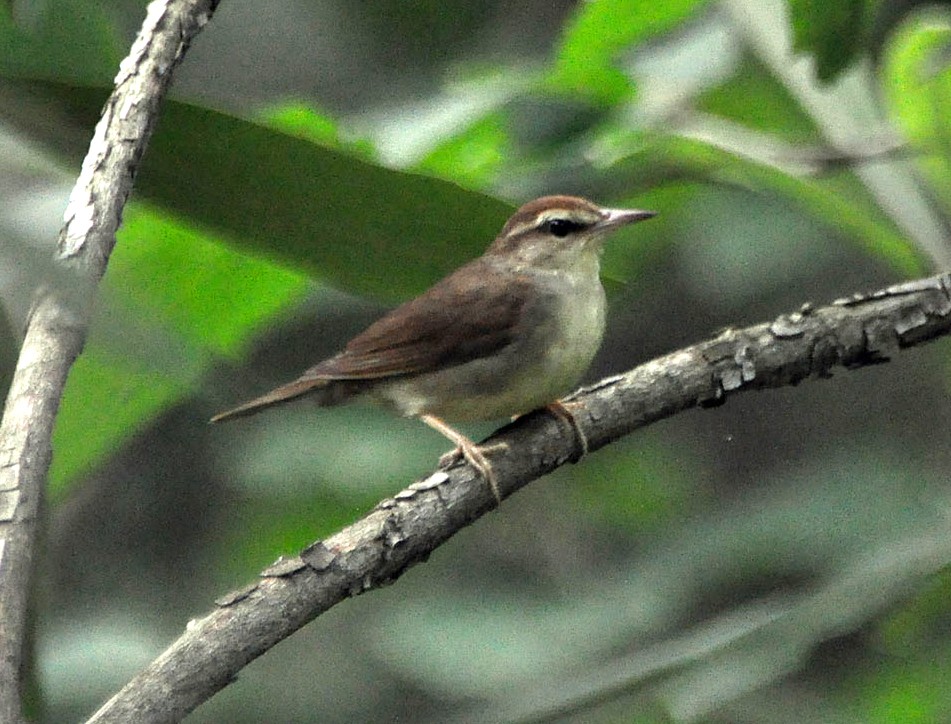Swainson's Warbler
A species of Swainson'S Warblers Scientific name : Limnothlypis swainsonii Genus : Swainson'S Warblers
Swainson's Warbler, A species of Swainson'S Warblers
Botanical name: Limnothlypis swainsonii
Genus: Swainson'S Warblers
Content
Description General Info
 Photo By Don Faulkner , used under CC-BY-SA-2.0 /Cropped and compressed from original
Photo By Don Faulkner , used under CC-BY-SA-2.0 /Cropped and compressed from original Description
Swainson's warblers are a small and rather nondescript songbird, though are fairly large for a New World warbler. Adults grow to 12.5–16 cm (4.9–6.3 in) in length and 11–20.5 g (0.39–0.72 oz) in weight. The wingspan averages 23 cm (9.1 in). They are a plain olive-brown above and pale yellow-white below. They have a whitish eyebrow stripe that runs above their eye, and the top of their head is a rusty brown. Unlike most other New World warblers that are mostly dimorphic, there is no difference in appearance between a male or female Swainson's warbler. 
Size
13-14 cm (5-5.5 in)
Colors
Brown
Yellow
Bronze
Gray
White
Life Expectancy
8 years
Nest Placement
Shrub
Clutch Size
1 - 7 eggs
Incubation Period
1 brood
Number of Broods
11 - 15 days
Nestling Period
8 - 12 days
Feeding Habits
Swainson's Warbler predominantly consumes ground-dwelling insects, including ants, bees, wasps, crickets, and caterpillars, plus spiders, centipedes, and insect eggs. They exhibit ground-foraging behavior, flipping leaf litter while walking slowly, occasionally gleaning from plants. In winter, tiny lizards are also eaten.
Habitat
Swainson's Warbler primarily thrives in the dense undergrowth of mature bottomland hardwood forests, with a preference for areas featuring well-developed canopies and rich leaf litter. Habitats favored by this species include those with dense understory vegetation, such as Viburnum and holly, vine-covered terrains, and forested mountain ravines with rhododendron thickets. During migration, swainson's Warbler utilizes woodland habitats with substantial ground cover across the southeastern U.S., the Caribbean, and southern Mexico.
Nest Behavior
Swainson's Warbler's females erect the suspended nests, followed by egg-laying and caring for the young. The construction timing and egg-laying patterns are closely tied to the breeding season, with both parents involved in nurturing the offspring.
Nest Characteristics
Swainson's Warbler nests are above ground, intertwined in vines, cane, or shrub forks. They have a disheveled exterior of leaves and sticks, masking a leaf and twig cup, lined with fine materials like pine needles and moss. These nests measure about 5.5 inches wide and 3.4 inches tall.
Dite type
Insectivorous
General Info
Feeding Habits
Bird food type
Bird Feeder Type

Platform
Behavior
Swainson's Warbler are known for their secretive and elusive nature, making them a challenge to observe in the wild. Upon their spring arrival to breeding grounds, male swainson's Warbler promptly establish extensive territories, which they energetically defend from competitors. Their defensive actions include cautionary and swift flight patterns, loud vocalization, chases, and, occasionally, direct attacks on intruders. Such combative displays might comprise unique gestures like spreading and vibrating wings and tail feathers, coupled with raising the crown. Although not frequently witnessed, these behaviors are also thought to play a role in courtship rituals. Contrary to males, female swainson's Warbler display less territorial behavior. The species tends to follow a monogamous mating system with rare cases of polygyny reported. During breeding, mated pairs exhibit cooperative tendencies, staying in proximity while foraging, with males often provisioning females during incubation. Both parents are actively involved in feeding their offspring in the nest and post-fledging. During migration and winter, swainson's Warbler prefer habitats with structural resemblance to their breeding and wintering environments, where they maintain territories against conspecifics.
Distribution Area
Swainson's warblers are uncommon, mostly found in flooded swamplands and canebrakes of the south-eastern United States. More rarely, they will also occur in rhododendron thickets in the southern Appalachian Mountains. They are a migratory species, with part of the population migrating southeastwards to the Greater Antilles (where it overwinters in the Blue Mountains of Jamaica for example) and the other southwestwards to the Yucatán Peninsula region in winter. 
Species Status
Not globally threatened.
Scientific Classification
Phylum
Chordates Class
Birds Order
Perching birds Family
New world warblers Genus
Swainson'S Warblers Species
Swainson's Warbler